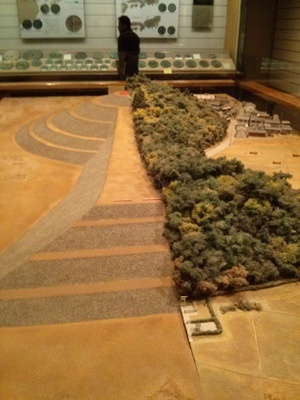Kofun

- Japanese: 古墳 (kofun)
Kofun are tomb mounds, erected mainly from the late 3rd century to the early 7th century. Outside of this historical period, the term funkyûbo 墳丘墓 is used instead.
This mode of burials for local or regional elites, along with the technology or techniques for doing so (e.g. earthmoving, quarrying and carving of stone, construction of stone burial chambers, etc.) is believed to have come from cultural interactions with communities on the Korean Peninsula, where similar burial modes were practiced. Though they resemble natural hills, and were initially built atop natural hills for more impressive size, kofun are manmade mounds, built up over burial chambers. From the fifth century on, they began to be built up from flat areas of land, though some of the latest kofun, from the sixth century, were built on mountainsides. Kofun can be found in a wide variety of sizes and shapes, though the most famous and distinctive ones are keyhole-shaped, with a circular section connected to a fan-shaped section, and are quite impressive in size. The largest and most famous kofun are mainly concentrated in the Kinai region (in and around Nara, Osaka, and Kyoto), but roughly 150,000 tomb-mounds have been identified throughout much of Honshû, Shikoku, and Kyushu.
Large kofun were typically located at some distance from the settlement, and were topped or ringed with clay figurines known as haniwa. The tombs themselves generally contained one or more burial chambers, with stone coffins and a variety of burial goods, including swords, helmets, armor, saddles, mirrors, and a variety of tools and ornamental or luxury objects.
Types of Kofun
- Enpun 円墳 (A circular tomb)
- Houfun 方墳
- Hakkakufun 八角墳
- Chouhoufun 長方墳
- Souhouchuenpun 双方中円墳
- Souhouchuhoufun 双方中方墳
- Zenpôkôenfun (Keyhole shaped tomb) 前方後円墳
- Zenpoukouhoufun 前方後方墳
- Souenfun 双円墳
- Souhoufun 双方墳
Kofun could be entered in generally one of two ways:
- Yokoanakofun 横穴古墳
- A kofun with a side, hall-way like entrance
- Tateanakofun 竪穴古墳
- This style of kofun was entered from above, compared to the Yokoanakofun
References
- Conrad Schirokauer, David Lurie, and Suzanne Gay, A Brief History of Japanese Civilization, Wadsworth Cengage (2013), 11-13.
- Piggott, Joan. The Emergence of Japanese Kingship. Stanford University Press, 1997.